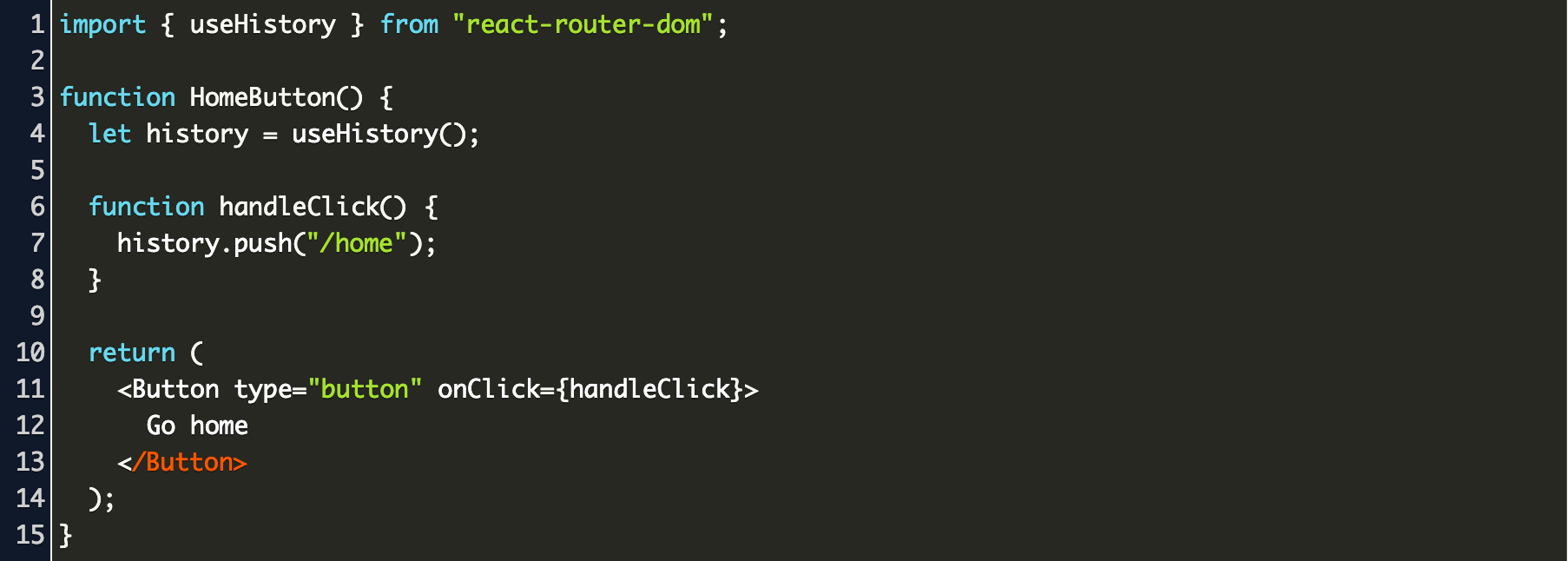
- React router dom history initialize how to#
- React router dom history initialize install#
- React router dom history initialize full#
- React router dom history initialize code#
So let's create a route for homepage about page and profile page. So what are we what are we going to do next is we're going to create different different routes for different different pages that we're going to work with. I think I'm going to have to restart my application. So I'm going to go to my app JS component.Īnd to use our react router DOM, what we'll need to do is we're going to have to cover this whole react app in something called browser router, browser router, which comes from react router DOM, so you can see it has auto imported.
React router dom history initialize code#
So if you don't know what react fragment is, you can watch my previous video on eight clean code practices in react, it's going to help you a lot 2000 years later, or it's finally a react router Dom has installed successfully.

So I'm going to open a new terminal and type NPM I react router DOM.Īnd you know what I'm gonna go to header and get rid of this dev Let's use the React fragment.
React router dom history initialize install#
So now we're going to install react router DOM. I mean to say align items to center and flex direction is going to be column because we want everything to be top down.

I'm going to get rid our display flex and justify content. So I'm going to give it a few of the styles in app dot CSS. I'm going to create a different component for header dot j, s.Īnd I'm going to type our A, F, C underscore RFC and press Enter.Īnd then we're going to start with our tutorial. When you create a new component called a new folder called components, it's not necessary to create a separate folder for components, but it's a good practice. So let's create a different component for header. Yes, it has successfully rendered this over here. Okay, so what I'll do now is I'm going to type h1, h1, react, router Dom tutorial, for this react router tutorial. Inside app j s, app dot j s, I'm going to get rid of this.Īnd now you'll see that our app will have nothing to show. So what I'm going to do now is I'm going to go I'm going to go to the src folder.Īnd I'm going to get rid of those things that we don't need this, this, this and this, we're going to get rid of these four files.Īnd we're going to remove the places that they were being used.Īnd we're going to get rid of all of these styles. Here's our react app running successfully. So what I'm going to do now is I'm going to type NPM start. I folder has been opened in the VS code successfully. Or what you can do is you can open that folder in VS code, which in my case is this folder.

Now we need to switch to that folder, what we can do is either we can type cd, and the name of the folder, you can switch this way. Now what is going to do, it's going to go to NPM website or NPM repository and going to take all of the things needed to create a new react app.Īnd it's going to put all of those things into this folder, React router tutorial, it's going to find all of the dependencies that we need to create our react app.Īnd it's going to basically initialize a boilerplate code for our react app.Īlright, so it has successfully initialized our new react app. I'm going to type NP x create react app, and the name of our app, which I'm going to give react router tutorial. Okay, so let's start by creating a new react app.
React router dom history initialize how to#
Hooks like US history, use params, use locations and use route match, also how to fetch a query string in form of a variable from the URL. This course will teach you how to use react router to create your own routes in react, we're going to learn about react router, and its different concepts such as creating different routes for different pages in react.Īlso, we're going to learn how to nest a route of a page under another page. React router is commonly used to create different routes for pages in react applications.
React router dom history initialize full#
Watch the full course below or on the YouTube channel (1-hour watch). Here are the topics covered in this course:

It also covers match and history props, including useHistory, useParams, useLocation, and useRouteMatch Hooks. This course covers BrowserRouter, Switch, Nesting Routes, and Redirecting Routes. Piyush is a prolific course creator on his YouTube channel and is very experienced with React. We just released a crash course on the YouTube channel that will teach you how to create routes in your React applications. React Router is commonly used to make different routes for pages in React Applications.


 0 kommentar(er)
0 kommentar(er)
